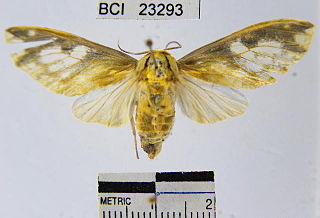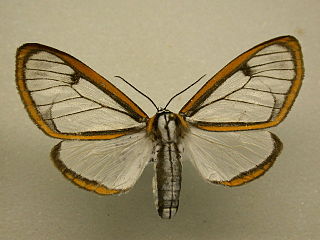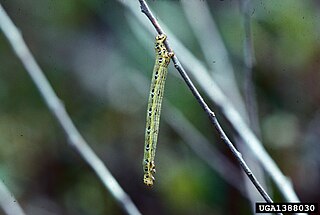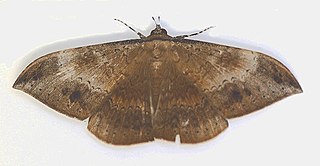
Castrica is a genus of moths in the family Erebidae. The genus was erected by William Schaus in 1896.

Hyalurga is a genus of tiger moths in the family Erebidae. The genus was erected by Jacob Hübner in 1819.

Cingilia is a monotypic moth genus in the family Geometridae erected by Francis Walker in 1862. Its only species, Cingilia catenaria, the chain-dotted geometer, chain dot geometer, chainspotted geometer or chain-spotted geometer, was first described by Dru Drury in 1773. It is found in North America from Nova Scotia south to Maryland and west to Kansas and Alberta.

Hemeroblemma opigena is a species of moth in the family Erebidae first described by Dru Drury in 1773. The species is found from Florida to Brazil.

Argina astrea, the crotalaria podborer, is a moth of the family Erebidae. The species was first described by Dru Drury in 1773. It is found in eastern Africa, southern Asia of India, Sri Lanka, and Indo-Australia, including the Pacific Islands and Australia.

Junonia terea, the soldier pansy or soldier commodore, is a butterfly of the family Nymphalidae. The species was first described by Dru Drury in 1773. It is found in the Afrotropical realm.

Apantesis nais, the Nais tiger moth, is a moth of the family Erebidae. It was described by Dru Drury in 1773.

Castrica phalaenoides is a moth of the family Erebidae first described by Dru Drury in 1773. It is found in Mexico, Guatemala, Panama, Honduras, Costa Rica, Brazil, French Guiana, Peru, Venezuela, Ecuador and Trinidad.

Hyalurga dorsilinea is a moth of the family Erebidae. It was described by Hering in 1925. It is found in Ecuador.

Hyalurga fenestra is a moth of the family Erebidae. It was described by Carl Linnaeus in his 1758 10th edition of Systema Naturae. It is found in Costa Rica, Nicaragua, Panama, Bolivia, Suriname, French Guiana, Brazil, Peru and Venezuela, as well as on the Antilles.

Hyalurga lauronoides is a moth of the family Erebidae. It was described by Hering in 1925. It is found in French Guiana.

Hyalurga sixola is a moth of the family Erebidae. It was described by William Schaus in 1910. It is found in Ecuador, French Guiana, Guatemala, Costa Rica and Mexico.

Hyalurga peritta is a moth of the family Erebidae. It was described by Hering in 1925. It is found in Brazil and Paraguay.

Hyalurga urioides is a moth of the family Erebidae. It was described by Schaus in 1910. It is found in Costa Rica, Guatemala, Belize, Panama, Ecuador and Peru.
Hyalurga grandis is a moth of the family Erebidae. It was described by Herbert Druce in 1911. It is found in Peru.
Hyalurga leucophlebia is a moth of the family Erebidae. It was described by Hering in 1925. It is found in Brazil, Venezuela and French Guiana.
Hyalurga melania is a moth of the family Erebidae. It was described by Hering in 1925. It is found in the Neotropical realm.
Hyalurga supposita is a moth of the family Erebidae. It was described by Hering in 1925. It is found in Peru.

Hypocrita pylotis is a moth of the family Erebidae. It was described by Dru Drury in 1773. It is found in Honduras.

Crameria is a monotypic moth genus in the family Noctuidae erected by Jacob Hübner in 1819. Its only species, Crameria amabilis, was first described by Dru Drury in 1773.














